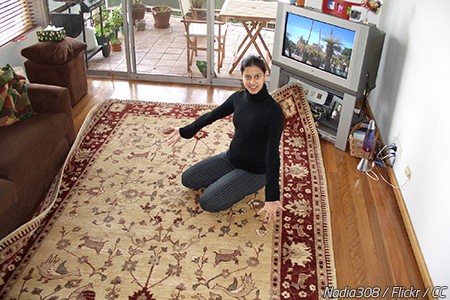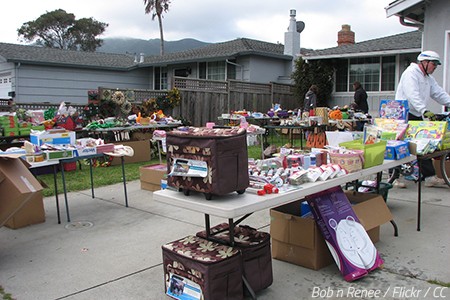When you’re getting ready to move out, one thing you’ll learn almost right away is that some things are much easier to pack up for moving than others.
For example, you won’t have to worry too much about moving soft items such as clothes, blankets, quilts, sheets, and even shoes. Why? All these soft goods are not breakable and are almost guaranteed to reach the new home perfectly intact.
On the other hand, there will be many highly breakable items in your home that you’ll need to pack up as well – glassware, kitchen plates, electronic devices, artwork pieces, lamps, jewelry, and so on. Most furniture pieces can also be rather delicate and will require proper packing materials to survive the move.
And then, there are some household items – such as area rugs, for instance – that seem easy to pack but are, in fact, quite tricky to protect properly for a move. And when you’re moving expensive rugs between two homes – such as Persian rugs – then you do want to make sure that the floor coverings will stay 100% safe during transit.
Here’s how to best pack rugs for moving regardless of whether the carpets are fairly inexpensive or super-valuable.
What to do before packing rugs for moving: 3 steps
Before you rush to pack all rugs in your home, there are a few things that you’ll need to do first to ensure a smooth packing process from start to finish. It’s important to be well prepared for the packing task ahead of you instead of starting to pack up your things without a good idea of what you’re actually doing.
Step 1. Decide if the rugs are worth moving
The very first step to packing rugs for moving is to answer the critical question of whether those area rugs are worth moving at all. Needless to say, you shouldn’t waste your time and money to transport any common area rugs that you can’t use in the new home for one reason or another.
The decision of whether you should pack and move a rug should be taken on a case-by-case basis. Answer these example questions to make the right choice:
Do you like the rug? Is it pretty?
Is the rug fairly new?
What’s the overall condition of the rug: excellent, good, acceptable, or bad?
What’s the quality of the rug?
Does the rug have any sentimental value for you?
If you come to the conclusion that some of your area rugs are definitely not worth the time, money, and effort to move to the new home, then you should give them away or dispose of them in accordance to the local recycling guidelines.
But if you do decide that there are some rugs you just have to take with you, then it’s time to go to step 2 which is all about securing the proper packing materials.
Step 2. Get the required packing supplies
Luckily, you will only need a few basic packing materials to protect your rugs during the move.
Clean the area rugs before packing them up for transportation.
Kraft paper. The harder brown packing paper will do a good job of protecting your area rugs during transport. A roll of 100 feet of Kraft paper costs around $15 and you can use the packing materials for packing up plenty of other items in the home too.
Twine. You’re going to need twine strings to tie up the ends of the rugs once they are properly packed in a roll. Twine is inexpensive – you can buy a ball of cotton household twine (roughly 400 feet) for about $3.
Packing tape. You can use your regular packing tape to secure the packing paper onto the rugs so that the bundle won’t get undone during the relocation.
Step 3. Vacuum the rugs
The third step when moving rugs is to clean those carpets so that you don’t transport any dust, dirt, or debris with them to the new home. If you have a cat or a dog, then your area rugs are likely to have some hairs on them too, so it’s really a good idea to vacuum the carpets before you pack them up for transport.
If any of the rugs happen to be stained but you still want to take them with you, then consider having them cleaned professionally before packing them. When pressed for time, you can still take them to professional cleaners after the move.
Packing Checklist: Packing Timeline for Moving
How to pack area rugs for moving: 5 steps
First of all, we’re going through the best way of packing area rugs for moving. Such small rugs are very common and can be found in almost any home.
Once you have decided which areas rugs you’re moving and have cleaned them well to avoid introducing dirt and possible hairs into the new place, it’s time to protect the carpets so that nothing happens to them in the meantime.
Step 1. Identify the direction of the nap
The fibers of a rug have a certain direction that’s called a nap (rug pile). To pack a rug safely, you’re going to have to figure out the correct direction of the nap. But how can you do it?
Have your hand slide along the top surface of the rug. When you go in one direction (either left to right or right to left), the hand will glide smoothly along the rug pile and you won’t feel any resistance from the fibers at all. However, when you go the other direction, the palm of your hand should feel the friction along the carpet and it won’t slide smoothly along the surface.
Therefore, when your hand is moving smoothly along the nap, then you’re going with the grain of the rug and when your hand is moving with difficulty along the surface of the carpet, then you’re going against the grain of the rug.
Step 2. Turn it upside down
Once you’ve determined the direction of the nap, the next step is to turn the rug upside down so that the fibers are facing the floor.
The reason why you should do this step is that the backing of the rug will be put under additional strain if the fibers are facing you while you’re folding the rug for moving. And such extra pressure may stretch or crack the backing of the rug.
So, remember to place the area rug upside down prior to folding it.
Step 3. Roll the area rug
Roll your rugs in tight bundles to keep them safe on the road.
Begin to roll the area rug into a tight roll but be careful to do it against the direction of the nap. And since you’ve already determined the direction of the grain in Step 1, there shouldn’t be any confusion about which way you should fold the rug for moving.
Keep rolling the carpet slowly and evenly in order to create a firm and tight bundle. Ultimately, the better you roll the area rug, the easier it’ll be for you to carry it outside the home and load it onto the truck.
Step 4. Tie up the rug
When you finish rolling up the area rug into a tight bundle, you should secure the carpet roll at each end with a piece of twine. The idea here is to ensure that the rolled-up rug won’t unfold by itself during the transportation phase.
Use pieces of twine and never packing tape for the purpose because tape may easily damage the delicate surface of the area rug.
Step 5. Wrap the rug in paper
This final step of packing an area rug for moving is all about physically protecting your carpet during the house move.
Once you tie up the carpet roll at its ends, wrap the bundle well with sheets of hard Kraft paper. Then, use pieces of packing tape to secure the protective paper and you’re done.
Remember not to use plastic wrap to protect your carpet for the upcoming move. While a plastic cover will definitely keep dust and dirt away, it will most likely trap moisture inside and will prevent the fabric from breathing, which could ultimately cause mold to develop.
Moving by Yourself? Don’t Make These Costly Mistakes
How to pack oriental rugs for moving: 7 steps
If you happen to own an oriental rug, then you’ll surely want to take it with you when moving to another home. The reason is simple enough: hand-made oriental rugs are quite expensive so you won’t want to part with yours just like that.
Keep in mind that oriental rugs – most often Persian rugs – are never rolled up like ordinary area rugs (see above). Because of their large dimensions and their structural fragility, oriental rugs are instead carefully folded in a specific way that makes them more compact and easier to transport while keeping them structurally sound.
These steps will show you how to pack oriental rugs for moving:
Step 1. Turn the Persian rug upside down
Once you’ve vacuumed carefully the large oriental rug so that it’s free of any dust, dirt, and debris, it’s time to fold it properly with the purpose of making it more compact. Most oriental rugs are big in size, so it’s a good idea to have another person to help you pack them quickly and safely
Turn the Persian rug upside down – the rug pile should be facing the floor – the same way you did with the smaller area rugs. It’s best if you complete this first step together with your helper due to the large size and substantial weight of the carpet.
Step 2. Fold the oriental rug into thirds
This step will show you how to fold the oriental rug so that it becomes smaller and easier to roll later on.
Take one corner of the carpet and fold it toward the center in a lengthwise way, approximately to the middle line of the rug. Then, take the other still open end and fold it over the part that you’ve just folded.
The idea here is to have three layers of the rug positioned on top of each other, folded neatly into thirds.
Step 3. Fold the rug onto itself
Proper folding is the secret to packing oriental rugs for moving.
Grab one end of the folded carpet with your hands and walk back over the oriental rug, folding it onto itself. Make sure you’re folding the big carpet against the grain to facilitate the final packing steps.
Stop walking before you reach the opposite end of the rug and leave approximately 3 feet of carpet unfolded.
Step 4. Roll up the folded section
Begin to roll the section of the rug that’s already folded against the grain. Do it slowly, creating a tight carpet roll as you go along. Stop rolling when you reach the part of the carpet that you haven’t folded yet – that is, the 3-feet section of your Persian rug.
Step 5. Roll up the entire rug
Take the 3-feet unfolded part of the carpet and fold it backward until it ends up touching the folded section. Then, fold both sections one over the other to form one tight bundle of carpet.
This method of folding an oriental rug does not put any pressure on the foundation of the carpet, making it the best way to pack Persian rugs for moving. In fact, the packing technique takes advantage of the way carpets tend to roll naturally without sustaining any type of damage in the process.
Step 6. Tie up the oriental rug
Use pieces of twine to tie each end of the newly-formed carpet roll.
Don’t use too much force when tying the strings to avoid possible structural damage to the Persian rug itself. The aim is to simply secure the roll so that it won’t get unfolded when you’re carrying it to the moving vehicle.
Step 7. Wrap the rug in paper
The final step is to wrap the entire carpet roll in hard packing paper (Kraft paper) for extra protection. Once you’re done, use small pieces of packing tape to secure the paper layer over the rug.
Don’t use plastic to wrap your oriental rug for fear of trapping moisture inside the cover which could lead to the formation of mold or mildew.
Packing a rug for moving is not too complicated and you can complete the task either on your own (when packing small area rugs) or with the help of an assistant (when packing large oriental rugs).
Nevertheless, if you feel nervous about the safety of your super-expensive Persian rug, then don’t hesitate to hire professional packers who know exactly what it takes to protect rugs and carpets for a move.
How to Find the Best Movers Near You
The post How to Pack Rugs for Moving appeared first on The Moving Blog.







